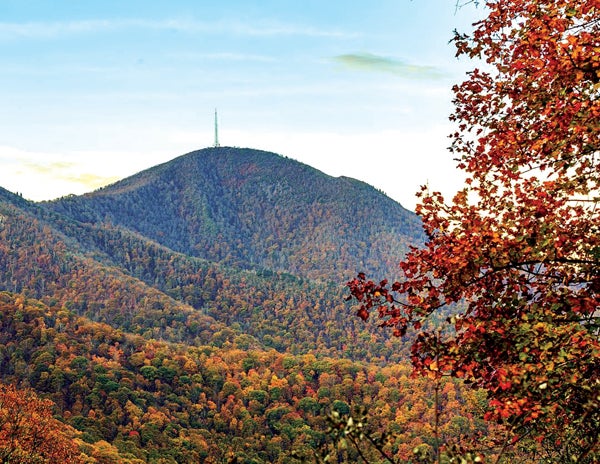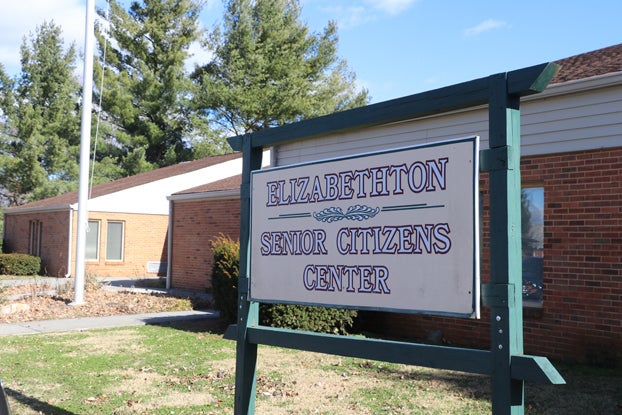Side trips are part of the fun of going places in the southern hills
Published 12:35 pm Friday, July 24, 2020

- Photo contributed Mount Pisgah near Asheville, N.C., is accessible from the Blue Ridge Parkway, and is a favorite hiking spot for outdoorsmen.
|
Getting your Trinity Audio player ready...
|
By MICHAEL FROME
ASHEVILLE, N.C. — Take the Blue Ridge Parkway south. Then, as the Lord directed Moses, go to the top of Pisgah and view the promised land.
It was near pyramid-shaped Mount Pisgah— the one in North Carolina— that George Washington Vanderbilt erected his hunting lodge in order to enjoy the unlimited vistas. Lofty Pisgah, over a mile high, was part of the more than 125,000-acre estate that Vanderbilt acquired before the turn of the century.
Today’s visitors on the parkway are welcome to share much of the same glorious scenery known only to native mountaineers born to it and men of wealth who bought into it. But in addition, as I travel over this route it strikes me that the parkway and its northern link in Virginia, the Skyline Drive, constitute more than a road, more than a recreation area in their own right, but also a gateway to such regions as the vast forested bowl spread out below Pisgah.
Many opportunities for side trips present themselves. They furnish close-ups of mountain culture, scenery, history, and of mountain communities in a time of transition. A few well-chosen digressions are in order; they complement the drive and add extra qualities to it.
For instance, the road down from Pisgah leads to the Cradle of Forestry, a 6,500-acre outdoor museum commemorating the site where forestry was first practiced and taught in America. The visitor center and restored mountain cabins— the “campus” —recount George Vanderbilt’s sponsorship of pioneer efforts in conservation. Along the trail, hands-on exhibits, crafters at work, an old logging locomotive and portable sawmill add to the picture of what life was like.
Much of Pisgah National Forest in this vicinity is devoted to recreation and scenic enjoyment. Sliding Rock, a sixty-foot-long cascade, is at its best when it earns its name, sending swimmers splashing into a clear pool below. Just beyond, Looking Glass Falls is one of the most beautiful waterfalls of the southern mountains, whether to contemplate or photograph. At the Pisgah Center for Wildlife Education and adjacent state fish hatchery, families can learn about the importance of mountain streams, where water and life begin, and how brown, brook and rainbow trout are spawned, raised, and stocked.
The story of George Vanderbilt, scion of wealth, patron of art and culture, is intriguing and worth pursuing. While Pisgah National Forest was developed around the nucleus of his estate, his headquarters were in Asheville, where the Biltmore House, his cozy 250-room French Renaissance chateau, remains largely intact, a monument to the age of opulence. If the tapestries, paintings, porcelain and other old world treasures fail to impress the visitor, the bordering gardens contain more than 250 varieties of roses, thousands of oriental azaleas, and a collection of native American azaleas. Add to that a working winery that produces award-winning wines available for tasting and a quaint village that takes its guests back to the days of the Vanderbilts, plus dining and recreation opportunities, and Biltmore Estate is definitely a full-day adventure.
Other homes of note are in the area, too. A North Carolina state historic site contains the Asheville boyhood home of Thomas Wolfe and an adjacent visitor center, both of which interpret Wolfe’s life and work. Though his epic Look Homeward, Angel at first was banned from Asheville’s public library, the book has remained popular since publication in 1929 and this home a part of the nation’s literary history. The Urban Trail in downtown Asheville links thirty points of interest, including the art deco city hall and the Pack Place cultural center.
Another noted author, Carl Sandburg, spent the last twenty-two years of his life in Flat Rock, outside Hendersonville. Connemara, his home and farm, now a national historic site, is too good and too close to miss, remaining largely as he and his wife left it, reflecting his immersion in poetry and history and hers as a breeder of prize goats. Nearby Flat Rock Playhouse, the state theater of North Carolina, provides quality theater productions.
At the outskirts of Asheville (parkway exit at French Broad River, Milepost 393.6), a major point of interest, the North Carolina Arboretum, includes 434 acres of gardens, greenhouse and educational displays, with miles of hiking and biking trails. The arboretum, “a natural cradle of plant cultivation,” was chosen as site of the World Botanic Gardens Congress in late June 2000. And another major facility alongside the parkway, the Billy Graham Training Center at The Cove, covers 1,500 acres with impressive buildings and landscaped grounds meant for spiritual retreat.
East of Asheville lies Chimney Rock with its ancient monolith, 404-foot waterfall, hiking trails and awe-inspiring views overlooking the charming villages of Chimney Rock and Lake Lure. South of Chimney Rock lies Hendersonville with its beautiful village-like downtown and Brevard with its waterfalls and summer music series. Adjacent to both towns is the DuPont State Recreational Forest with miles of hiking and biking trails and multiple scenic, easily-accessible waterfalls.
The Blue Ridge Parkway terminates in Cherokee, N.C., where it intersects a federal highway (US 441) to cross the Smoky Mountains into Tennessee. The Qualla Boundary, the home of the Eastern Band of Cherokee Indians, has become a point of interest in its own right. The Museum of the Cherokee Indian, the outdoor drama “Unto These Hills,” and the recreated 18th century settlement called Oconaluftee Indian Village reflect determination to safeguard and interpret Cherokee culture and heritage.
Overnight accommodations, campgrounds, tourist services and attractions of various kinds are accessible via side trips from the parkway. On the North Carolina side of the Great Smokies, community services are provided in Waynesville, Maggie Valley, Sylva and beyond, and on the Tennessee side in Gatlinburg, Pigeon Forge and Sevierville.
North of Asheville, the motorist explorer can take a five-mile side trip off the parkway to Mount Mitchell State Park, the highest mountain in eastern America, or stop at the resort community of Little Switzerland and visit the Museum of North Carolina Minerals. Towns like Black Mountain, Burnsville and Mars Hill are cradled by mountains and surrounded by gorgeous views. Country inns, bed and breakfasts, craft fairs and music festivals perpetuate tradition in a modern age.
The parkway north of Little Switzerland welcomes vacationers to the North Carolina High Country, a four seasons playground. Appalachian Ski Mountain and Beech and Sugar mountains offer snow sports for the beginner to the afficionado. Several famous attractions nearby are worth a visit: Linville Caverns, The Blowing Rock, Tweetsie Railroad, Mystery Hill, the outdoor drama “Horn in the West,” and Grandfather Mountain with its Mile High Swinging Bridge. Two schools, Appalachian State University and Lees-McRae College, provide excellent cultural programs and concerts. The village of Blowing Rock is the only town physically located on the Parkway.
Crossing into Virginia, the Shenandoah Valley provides many side trips. The Roanoke River Parkway provides direct access to Virginia’s Explore Park in Roanoke, with displays about early settlement and numerous outdoor adventure opportunities. Among other points of interests, the Virginia Museum of Transportation is one of the country’s largest collections of steam railroad engines and vintage vehicles.
Another possibility is to leave the parkway on the scenic road into Cave Mountain Lake Recreation Area, a part of Jefferson National Forest, then continue to the historic Natural Bridge, one of the natural wonders of the world which is now a Virginia state park. Nearby Lexington is one of the most interesting, inviting and significant small cities of the South. The Virginia Military Institute (VMI) and Washington and Lee University both have notable campuses associated with heroic personalities, but the whole town and countryside around them are heroic in their way, trying to conserve a traditional scene and to make it useful in a modern context.
A few miles north in Raphine, a restored blacksmith shop and demonstration farm memorialize the life of Cyrus Hall McCormick, whose invention, the mechanical grain reaper, revolutionized farming. At Staunton, the house where Woodrow Wilson’s father served as a minister, and a future president was born, has been restored as a national shrine at the Woodrow Wilson Presidential Library and Museum, a worthy introduction to Wilson’s career and age. From this point it is possible to drive directly to Rockfish Gap, the junction between the Blue Ridge Parkway and Skyline Drive, and resume the high road— or head down the foothills to visit Charlottesville, with the homes of two other presidents, Jefferson and Monroe, and the campus of the University of Virginia, which Jefferson designed.
On the other hand, Rockfish Gap and Staunton can be the start of another side trip, first heading north into an area known for vividly colored limestone caverns, several of which are open as private attractions. At New Market, the Battlefield State Historical Park marks a singular episode in history, the stand of young VMI cadets against seasoned Union troops at a time when Shenandoah Valley was the “breadbasket of the Confederacy.”
Turning east, the loop leads across the Massanutten Mountain, a great ridge fifty miles long, where the George Washington National Forest has developed picnic areas, campgrounds and trails. Then it continues to Luray, site of the noted Luray Caverns in Page Valley, before climbing to Thornton Gap on Skyline Drive, with recreational facilities of Shenandoah National Park at hand.
(The late Michael Frome, a founder and former president of the Society of American Travel Writers, wrote a series of four articles about the parkway for the Blue Ridge Parkway Association (BRPA). The BRPA recently updated them with current information so that they are still relevant to today’s traveler but retain Frome’s journalistic style and intent. Many of the places mentioned in the articles are opening to the public, but as is common now, each location is opening on a different schedule with varying degrees of facilities and services available, so it would behoove the traveler to confirm details with the sites prior to visiting.)



